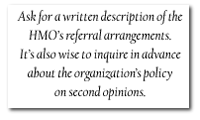
Main Menu ·
Search · Current Issue · Contact · Archives · Centennial · Letters to the Editor · FAQs

Go back to Part I, or see The ABCs of Managed Care
 |
HMOs emphasize prevention and early detection of disease. Photograph by FPG/Michael Krasowitz
|
The HMO Physician
A common misconception is that HMOs assign newcomers to a doctor, giving
them no say in the matter. That was the case years ago, leading some people
to shun managed care altogether. Today, HMOs routinely let people choose
their own primary-care doctor from among those who are on staff or who participate
in the network.
Recognizing that some people are uncomfortable about having their choice
limited in any way, many HMOs now offer a point-of-service (POS) plan that
allows members to go outside the network when they wish, although usually
they must pay a deductible as well as coinsurance-a percentage of the cost
of the visit or procedure.
Although some HMOs may be willing to add a doctor to the provider list
at a member's request, most expect people to pick one already in the network.
The choice of a primary-care physician has always been a weighty decision,
even under the fee-for-service system. Solid research and a face-to-face
interview are good starting points. Even then, the match may not be a good
one. It's prudent to find out in advance whether members can switch
doctors at will or only at certain designated times of the year.
Although many people focus on the selection of a primary-care doctor, access
to a wide range of specialists may be even more important. Although provider
directories list hundreds of specialists, each primary-care doctor may be
hooked into a network that funnels all his or her referrals to one cardiologist,
gastroenterologist, or rheumatologist. To find out if consultation
is restricted to specialists in the primary-care doctor's group, ask for
a written description of the HMO's referral arrangements. It's also wise
to inquire in advance about the organization's policy on second opinions.
Some managed-care organizations require a second opinion when something
costly, such as surgery or hospitalization, is recommended by a physician.
It's equally important to find out whether the plan will pay for one
when treatment is denied or the patient disagrees with a doctor's judgment.
HMOs do not ordinarily pay for second opinions from doctors outside of the
plan.

One of the most controversial aspects of managed care is how physicians
are paid. Although traditional fee-for-service medicine may reward overtreatment,
it enables doctors to act on what they believe is best for patients. Critics
now worry that HMO capitation plans may have flipped the coin, giving
doctors an incentive to withhold needed services. Doctors receive a monthly
stipend for each patient and can pocket what isn't spent on their care.
Some HMOs have special funds and bonus systems in addition to their basic
arrangement with doctors. For example, a percentage of a primary-care doctor's
compensation may be set aside to pay specialists and hospitals. Whatever
is left at the end of the year is distributed to the primary-care doctors,
forcing them to make a tough choice between being an advocate for patients
or looking out for themselves.
Recent articles in publications ranging from the New England Journal of
Medicine to the New York Times concern so-called "gag clauses"
in HMO contracts that ban doctors from discussing their compensation arrangements
with patients. Activists in several states are pushing for disclosure laws
that would break this silence.
Some patients feel more comfortable with staff-model HMOs, which pay their
physicians a straight salary. This eliminates monetary incentives to deliver
too much or too little care, but may also give the doctor little reason
to run a practice that is efficient or friendly.
Assessing Quality
Measuring the outcomes of care--and thus its quality--is not a simple task.
Many HMOs have come up with their own methods, but inconsistencies among
them make it difficult for consumers to make meaningful comparisons. This is
changing, however, as the National Committee for Quality Assurance (NCQA)
refines its system for assessing, measuring, and reporting on the outcomes
of care provided by HMOs. Of course the real test of an HMO will be how
well, and how consistently, it performs over the years. In the meantime,
several indicators of quality are available.
Accreditation. NCQA is responsible for accrediting the nation's HMOs, and
so far has reviewed about half of them. Because this program is so new,
lack of accreditation is not necessarily a black mark. After a thorough
review of the HMO's procedures and performance, NCQA awards one of four
ratings: full accreditation is granted for three years and indicates excellent
performance; one-year accreditation is given to HMOs that are well-equipped
to implement recommended improvements within the coming year; provisional
accreditation for one year is given to HMOs that have the potential for
improving; denial of accreditation indicates the HMO does not meet NCQA
standards.
So far about one-third of the reviewed HMOs have been awarded full accreditation.
A relatively young plan that earns a one-year or provisional rating on the
first pass, however, may be comparable to a well-established HMO with
full accreditation. On the other hand, denial should raise a red flag.
Consumers can obtain a list of all the health plans that NCQA has assessed
so far and the accreditation status for each one, plus a roster of those
awaiting review. Recently NCQA began offering two-page accreditation summary
reports that summarize findings for individual plans (see "see below for more information").
Report cards. Some HMOs are using data gathered by NCQA to prepare report
cards on their own performance. Eventually, these will give corporations
and individual consumers an objective way to evaluate competing plans. So
far, NCQA has generated local report cards for HMOs in Pittsburgh, Denver,
and Dallas.
 However, report cards may not tell the whole story. For example, an HMO
may look good because it routinely screens diabetic members for eye damage.
But if the plan fails to follow up with patient education and appropriate
treatment, the quality of its care is not as good as the report card suggests.
An HMO that serves a young, healthy workforce will also look better than
one serving Medicare beneficiaries.
However, report cards may not tell the whole story. For example, an HMO
may look good because it routinely screens diabetic members for eye damage.
But if the plan fails to follow up with patient education and appropriate
treatment, the quality of its care is not as good as the report card suggests.
An HMO that serves a young, healthy workforce will also look better than
one serving Medicare beneficiaries.
Member surveys. Prospective members should not put much stock in a member-satisfaction
survey conducted by an HMO and ballyhooed in advertisements. Independent
studies conducted by organizations such as NCQA and the Center for the Study
of Services are more reliable. While some of the nation's largest HMOs have
cooperated with studies of member satisfaction, others have not. An important
caveat about patient-satisfaction information is that HMOs, like traditional
indemnity plans, also "cherry pick"-so a high level of satisfaction
may in fact mean that many members haven't sought services.
As anyone who keeps up with the news is aware, some HMOs have been sued
for malpractice or for refusing to authorize expensive but potentially lifesaving
treatments. Formal complaints about medical care are registered with state
health or insurance departments, and resourceful consumers can sometimes
obtain this information for HMOs, hospitals, and doctors.
Finally, people might do well to remember the adage that the best advertisement
is a satisfied customer. Ask about the experiences and opinions of
friends, neighbors, coworkers, local health-care professionals, and other
trusted people before signing on the dotted line.
For More Information
· How to Find the Best Doctors, Hospitals, and HMOs for
You and Your Family: Pocket Guide, (Castle Connolly Medical Ltd., 1995,
435 pages, $9.95).
· Managed Care & You: The Consumer Guide to Managing Your Health
Care, by Michael E. Cafferky (Practice Management Information Corporation,
1995, 199 pages, $14.95; call 800-medshop to order).
· Consumers' Guide to Health Plans (Center for the Study of Services/Consumers'
Checkbook, 1995, 96 pages, $12). Mail a $12 check made out to Consumers'
Guide to Health Plans, 733 15th St., N.W., Suite 820, Washington, D.C. 20005.
· For a free copy of the NCQA Accreditation Status List (ASL), which
lists all the names a health plan is marketed under, and whether a summary
report is available for the plan, contact NCQA's Publications Center at
800-839-6487. Individual summaries cost $3, but are available free of charge
on NCQA's World Wide Web site at https://www.ncqa.org.
Reprinted from The Harvard Health Letter. Copyright "
1996 President and Fellows of Harvard College. All rights reserved. For
subscription information, write Harvard Health Letter, P.O. Box 420300,
Palm Coast, Florida 32142-0300, or contact "pbibbins@warren.med.harvard.edu".
Main Menu ·
Search · Current Issue · Contact · Archives · Centennial · Letters to the Editor · FAQs

![]()



 However, report cards may not tell the whole story. For example, an HMO
may look good because it routinely screens diabetic members for eye damage.
But if the plan fails to follow up with patient education and appropriate
treatment, the quality of its care is not as good as the report card suggests.
An HMO that serves a young, healthy workforce will also look better than
one serving Medicare beneficiaries.
However, report cards may not tell the whole story. For example, an HMO
may look good because it routinely screens diabetic members for eye damage.
But if the plan fails to follow up with patient education and appropriate
treatment, the quality of its care is not as good as the report card suggests.
An HMO that serves a young, healthy workforce will also look better than
one serving Medicare beneficiaries.![]()